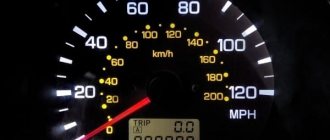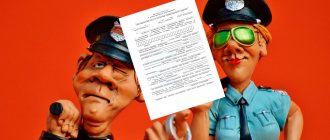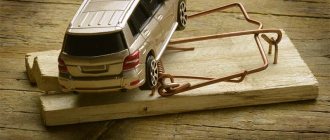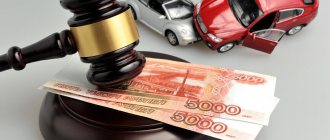What types of car dealerships are there?
Before you buy a used car at a car dealership, let's figure out what these sales points are. Conventionally, they can be divided into two types - official dealers and showrooms specializing in the sale of used cars.
Official dealers make a profit from the sale of cars from large automakers with whom they have a contract. Used copies usually come to them via Trade-in. That is, the buyer trades in his used car, pays extra and gets a new dealer car.
The second type is showrooms specializing in the sale of used cars. This is their main income. Often such a car dealership looks like an ordinary parking lot with many cars of different brands.
Bargaining based on the results of a technical check
Another way to reduce the cost of a used car at a dealership is to order an on-site inspection. Even if the car's history is clean, it may have technical flaws that can be easily detected by an experienced expert. The services of a specialist often pay off, since there are no perfect used cars, and a professional assessment can convince showroom employees to agree to bargain.
Expert analysis is also your confidence in a successful purchase. By turning to independent specialists, you can avoid expensive repairs (if the car has hidden defects).
Features of dealer showrooms
The undoubted advantage of such car dealerships is that they are concerned about their reputation and do not sell outright junk or a car with a dubious past. Although they are not immune from mistakes. But this is rather an exception to the rule.
They have one more feature. The segment of cheap cars from “officials” is poorly represented. For example, one of the largest sellers of used cars from an official dealer in the Sverdlovsk region currently offers only two cars cheaper than 350 thousand rubles.
If you don’t have enough money for a purchase, it will be useful for you to learn how to buy a car from a car dealership on credit.
Features and subtleties of a car on credit
A frequently asked question among car owners is which type of loan is more profitable. A consumer loan has several differences from a car loan:
- Collateral - if payment is not made, the loan of the car goes back to the bank, which then resells it.
- Drawing up an agreement is a complex, tedious task that needs to be done with a consumer loan, since you need to find a person to act as a guarantor.
- Interest – consumer loans may incur large amounts of interest.
- State programs - a car loan allows you to participate in the promotion from the region. The state can pay part of the interest on the loan, however, not all models and brands of cars fall into this program.
- A down payment is not required for a consumer loan, but for targeted lending this is the main condition.
- Insurance is the main requirement for taking out a car loan.
- Dealer - when applying for a loan, you need a car dealership salesperson who has an interest in making his profit, so there is a high probability that part of the money will have to be given due to his presence.
You need to choose a loan based on your needs, if you plan to buy an expensive car at reduced interest rates, exchange an old car with an additional payment for a new one, then you should give preference to a car loan. If you have a permanent job, a good credit history, and are unable to make a down payment, you should choose a consumer loan.
Pros and cons of official dealer showrooms
Buying a used car from an “official” dealership has the following advantages:
- Legal purity. Let us repeat, such showrooms value their reputation and check the car before purchasing.
- Upon acceptance, the salon diagnoses the car. At the same time, the qualifications of the technician and the service itself where the car is accepted are better from the “officials”.
- Service. In such a salon, no one will poke you or try to persuade you to buy in an aggressive manner. Some dealerships may provide a thickness gauge to help you make sure the car is unpainted.
- Guarantee. In the case of an official dealer, this is not a fiction. They will actually repair your car or refund your money if it has a significant defect.
Now let's move on to the cons:
- You will not be allowed to drive your car. The main reason is that the car does not have insurance, and the dealership does not want to increase the mileage.
- You may not be allowed to check the car properly. For example, the salon will not allow you to unscrew the spark plugs or measure the compression.
- Cars are more expensive. Dealerships are reluctant to reduce prices, while small firms sometimes allow the buyer to negotiate with the seller in person over the phone. Autocode already wrote about this earlier.
As you can see, such car dealerships have enough pros and cons.
Also read: Bargaining when buying a used car: how to reduce the price of a used car
Used car sales shops
There are many more nuances to such a deal. To buy a used car at a car dealership, you will have to carefully read the sales contract at least several times.
Be prepared for the fact that a small dealership will try at all costs to “pump” out of you a larger amount than what is indicated in the advertisement for the sale of the car. The “trick” of such a salon can be a 20-page purchase and sale agreement with a bunch of clauses. The calculation is simple. The buyer will get tired of constantly re-reading this Talmud and will not see important points. For example, those where it is written that you undertake to pay the salon 5-15 thousand for pre-sale preparation, drawing up a purchase and sale agreement, diagnostics, consultation during selection - there are many options.
Keep your eyes open, because after you cross out these points and the contract is printed again, the manager can quietly replace your copy. For example, by taking documents from you to put a stamp, or by “discovering” some incorrect items.
In such places, simply printing out a contract can take an hour. This is necessary so that the buyer’s attention weakens, and besides, you will be under pressure that the salon is about to close.
When buying a car, we recommend using the Autocode service for checking used cars. In just 5 minutes you will find out all the ins and outs of the car: whether it has any fines, arrests, whether it has been stolen, where it was serviced and much more. And most importantly, you will be sure that you are not being deceived.
Autocode is suitable if you need to check one or more cars. If you need to constantly check a large number of cars, use the “Autocode Pro” unlimited car check service. A subscription to unlimited car checks costs 2,500 rubles per month. “Autocode Pro” allows you to add comments to reports, create your own lists of liquid vehicles, quickly compare options and store data about cars in an orderly manner.
Methods of extorting money when buying a car on credit
Management prefers experienced salespeople who have the ability to persuade. They work in compliance with the law, taking advantage only of the inattention of buyers, and deceive at car dealerships when buying a new car on credit. To prevent such a situation, you need to have information about popular schemes.
Used car for the price of a new one
This type of fraud scheme is common in car dealerships, because it is not easy to determine what condition a car is in by its appearance. Even if you have any doubts, you will receive a prepared answer. It is better to pay attention to several situations that should alert you:
- an offer for a free technical inspection, providing a considerable discount on it;
- free extension of warranty service;
- There is an o. in the car's passport.
If you suspect that the car has already been used, then it is better to change the dealership.
Trade-in system
The Trade-in system involves exchanging an old car for a new one with an additional fee for the difference. This is a cunning method of extorting money. When inspecting the car, even if the car has no flaws, the salon will find reasons to reduce the price. Small external and internal damage will be made global, convincing the client of this, greatly reducing the price. After this, the car will be given away at the lowest price, and the new one at the highest. Therefore, it is better to sell the car yourself, avoiding unnecessary expenses.
Bonuses
Car dealerships can offer promotions when the purchase of a new car with the maximum equipment involves receiving an expensive gift: a recorder, video recorder, radio, a set of covers, mats, a rear view camera and others. In fact, the cost of the car will be the same or more without these “necessary” options.
Important! These bonuses are provided not by the salon itself, but by the manufacturer. Then the price of such gifts will already be included in the final cost of the vehicle, so such a promotion becomes profitable only for the car dealership.
Personal exchange rate
Car dealerships may issue agreements with prices converted to US dollars. The currency will exceed the official exchange rate of the central bank, which will become clear after the initial amount has been deposited. Therefore, if you find yourself in a situation where the price in the contract is in a foreign currency, then you have every right to ask for the equivalent in Russian rubles.
Maximum configuration
The salon needs to sell vehicles with additional equipment and accessories. The manager’s conviction that these gadgets are really needed will be convincing; it will be very easy to believe. Therefore, before visiting a car dealership, it is worth figuring out which elements will be needed and which will be a waste of money. All additional accessories can be purchased in other places where prices are much lower.
Wrong contract
Sometimes you find a car at a low price, pay a deposit, but the next day the real price is announced, which is higher than the original price. This is explained by the fact that an error occurred, an unexpected increase in price, or the end of the promotion. There is nothing complicated about collecting the deposit, but the manager points to the signed agreement, which states that the penalty will be paid in case of refusal. You have to lose money or spend additional funds.
Fictional buyers
Sometimes, when choosing a car, you can hear that although such a model is available in the showroom, it has already been reserved and therefore you will have to wait several months, however, with a small additional payment, you can agree with the buyer so that he gives in. The argument could also be that in a few months this particular model may become more expensive. If you compare it with the price of the vehicle, such a small amount seems small and therefore people often agree, even though there were no buyers.
Pros and cons of buying from an unofficial dealer
Let's start with the advantages for the buyer:
- Small showrooms have much more budget cars than “official” ones.
- Sellers agree to lower the price much more easily. If the car does not belong to the dealership, then the manager will try to “push” the owner on the price, just so that the deal goes through.
- Such salons are not so scrupulous and may allow you to drive. They also provide more freedom in terms of verification.
In the previous chapter we already named the main disadvantages. Let's name others:
- If after purchase the car is found to have defects, then it will most likely not be possible to receive compensation from the dealership. As we have already said, small car dealerships are not as worried about their reputation as dealerships.
- Legal and technical verification. If it exists, good, but it may well not exist. Not all car dealerships are ready to employ an acceptance specialist, and there may not be a workshop for accepting cars. Such sellers do not bother themselves much with checking the legal purity of the car.
- Psychological pressure. In such a company you will not always be served politely. Familiarity and an aggressive sales style are possible.
- Cars with damaged mileage, used in taxis, restored after an accident, “drowned” cars - all this is easy to find in a car dealership. Such cars are bought at a bargain price and, after restoration and polishing, are sold at exorbitant prices.
We have named the main problems that you are at risk of encountering. But keep in mind, dishonest sellers are constantly improving, because the purchase of used cars and their resale is the main source of income for “gray” showrooms, so there may be many more schemes to defraud the buyer.
Also read: How to check a car when buying at a car dealership
How to bargain correctly
Before you start haggling at a car dealership, conduct your own inspection of the car you are interested in. For this you can use
the Autocode service, which provides a detailed report on the car’s history in a matter of minutes. From it you will learn:
- the actual mileage of the car (the meter is often twisted);
- facts of road accidents (if any);
- restrictions;
- pledges;
- OSAGO data;
- customs history;
- history of fines;
- and also get a lot of other information.
If an independent check reveals facts that the seller was silent about, you can start bargaining. It is better to do this reasonably, confirming the words with iron facts from the history of the car. In this case, the car dealership will most likely accommodate you and reduce the price. The more convincing you are, the cheaper you will be able to buy a car.
If the report shows that the mileage was incorrect, and more than once, we recommend that you think about whether you need such a car. The car may already require major repairs, and it may have problems with the engine, chassis and gearbox. For that amount you can buy a much better car. And this is a serious reason for the seller to reduce the price. Think about how much you will have to spend on repairs if something happens, and insist on this discount.
Another case. The car was in an accident. The report shows the type of accident and the most significant damage resulting from it. From these data you can immediately understand how much, theoretically, will be needed for repairs after purchase. This is the amount you ask to be sent off. The exception is for cars after a frontal collision. It’s not worth buying them at all, since they can no longer be repaired.
Or, let's say, the car was listed as a taxi. This already suggests that she ran a lot. Moreover, passengers are delivered not only along smooth asphalt roads, but quite the opposite. Surely, the vehicle encountered stones, hummocks, and thickets. It is possible that some body elements (especially the suspension) will fail faster than usual. Request a discount of at least 10%!
Buying tips
To make buying a used car a joyful experience, follow these simple instructions:
- Before going to the salon, read reviews about it on the Internet.
- Take a friend with you. Ideally, someone who understands cars. But if there is no such person, you can take anyone, the main thing is not to go alone. This is necessary so that you can be stopped from taking rash steps, plus it will be easier to protect yourself from psychological pressure.
- Read the purchase and sale agreement carefully, no matter how many times it is reprinted. Ignore the manager’s words that this is the same contract that you just read. There they can change not only the item you knew about, but also any other.
- Before purchasing, look at the PTS and check the data from it with those specified in the contract. Sometimes sellers overestimate the year of manufacture, and after the buyer gives the money, the car suddenly “goes old”.
To be sure that the car is in good working order and has not been damaged, use the on-site car inspection service. An experienced technician will arrive at the right time, conduct an inspection and help you avoid making mistakes when choosing a used car.
How will a test drive help?
When buying a vehicle, you should pay attention not only to the papers, but also to its actual condition. The most convenient way to do this is with a test drive. Rules for its conduct:
- Carefully inspect the appearance of the vehicle. Even a new car can be damaged, for example, due to unsuccessful transportation. Pay special attention to the condition of the paintwork; it is this that suffers first.
- Listen to the engine running and make sure there are no extraneous noises.
- Inspect all external lighting fixtures for scratches and make sure they are working properly.
- Drive a car for at least 3-4 km, it is advisable that there are ups and downs along the way.
- Listen to the engine again, open the hood and inspect all components.
- Check the VIN numbers indicated on the body with those appearing in the documents.
If the driver does not have enough experience, then it is better to invite a specialist to conduct a test drive.









